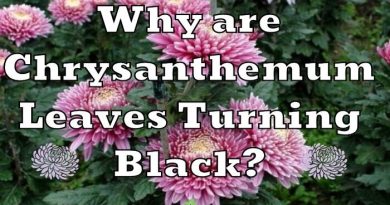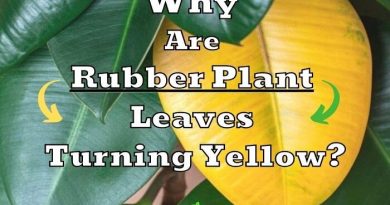Why Are Kalanchoe Leaves Turning Brown? Find Out Now!
Kalanchoe is a popular succulent that is not difficult to grow. But when carrying for my Kalanchoe succulent, I notice that leaves are turning brown.
Kalanchoe leaves can turn brown due to several reasons, such as excessive watering, underwatering, too much sunlight, pest infestation, diseases like late blight rot, or nutrient deficiencies. Identifying the underlying cause is crucial for treating and preventing the browning of the leaves.
| Why Are Kalanchoe Leaves Turning Brown |
|---|
| 1.Pests |
| 2. Not Getting Enough Water |
| 3. Overwatered |
| 4. Sunburn |
| 5. Insufficient Nutrients In The Soil |
| 6. Poor Soil Drainage |
| 7. Root Damage |
| 8. Late blight Rot |
In this article, I will share my knowledge and experience to help you identify the cause why kalanchoe has brown leaves.
1. Pests
Pests that can harm kalanchoe plants include spider mites, mealybugs, scale insects, and thrips. By eating the plants sap and damaging the leaves, these pests can cause the kalanchoe leaves to turn brown.
When pests such as spider mites and thrips feed on the plants sap, they puncture tiny holes in the leaves, resulting in brown blotches or streaks. Mealybugs and scale insects, on the other hand, attach themselves to the plant’s leaves and stems, draining the sap and causing the leaves to wither and turn brown.
Pests can also spread diseases to plants, causing brown spots or discoloration on the foliage. Furthermore, bug waste products might build on the leaves, causing brown stains and blemishes.
There are many methods for getting rid of bugs. You may be able to remove them by just spraying the plant with water, but you must take care to dry the plant if you go with this approach entirely.
Treatment
If you find brown spots or discoloration on your Kalanchoe plant, inspect it for pests and take the necessary steps to control the infestation. This could include applying insecticidal soap or oil, physically eradicating the bugs, or taking precautions to avoid further infestations.
2. Kalanchoe Not Getting Enough Water
Kalanchoe plants require plenty of water to keep their leaves healthy. When they do not get enough water, their leaves can turn brown. This occurs because water is required for various activities in the plant, including nutrient delivery and cell turgor pressure maintenance.
When a kalanchoe plant lacks water, the leaves lose turgor pressure and wilt. As a result, the plant cannot transmit nutrients properly, resulting in a buildup of waste products in the leaves. As a result, the kalanchoe leaves start turning brown before it dies.
Furthermore, when a kalanchoe plant does not get enough water, it becomes stressed, which causes the creation of a hormone called abscisic acid. This hormone can trigger the plant into dormancy or survival mode, conserving water by shedding leaves or slowing growth. This can also cause the leaves to brown.
Treatment
To prevent the browning of kalanchoe leaves owing to a lack of water, ensure the plant gets enough water regularly. Water the plant each time the top inch of soil feels dry to the touch, and keep the soil moist but not waterlogged. Proper watering and maintenance can help keep the plant healthy and prevent brown leaves.
3. Kalanchoe That Has Been Overwatered
When a Kalanchoe plant is overwatered, the plant’s roots become waterlogged and begin to rot. This can prevent the plant from adequately absorbing nutrients and water, causing the leaves to become brown and eventually fall off.
Furthermore, excessive wetness can serve as a breeding ground for fungal diseases, which can cause brown spots or blotches on the leaves.
Allow the dirt to dry out before watering the plant again to avoid overwatering. Choose well-draining soil and a pot with drainage holes to let the excess water drain.
Instead of leaving the plant in a saucer of water, remove any extra water that gathers in the saucer after watering. By following these measures, you can maintain your Kalanchoe plant healthy and avoid browning leaves caused by overwatering.
4. Sunburn
Sunburn occurs when a plant is exposed to excessive sunlight and heat, which can cause tissue and cell damage. Kalanchoe leaves are especially vulnerable to sunburn because they are thin and lack a thick waxy layer to protect them.
When exposed to direct sunlight for a prolonged period, the leaves of a kalanchoe plant can become discolored and brown.
It can withstand direct sunshine for a couple of hours, but any more than that, it will become sunburned. Sunburn is exacerbated if the plant is thirsty for water and the airflow is deficient in moisture.
Sunburn browning is simple to identify. The most vulnerable plant is one that is maintained outside in direct sunlight. One placed on the balcony of a southern-facing balcony is equally dangerous.
Treatment
To keep these plants safe, provide them with bright indirect sunshine. This gives them the sunshine they require to develop healthily while protecting the leaves.
When exposed to direct sunshine, numerous portions of the plant will become burnt. The leaves will certainly turn brown, and other parts of the plant may also develop brown blotches.
Fortunately, it is simple to avoid this predicament by planning ahead of time. Choose an excellent location where you can provide the plant with a bright light that is indirect enough not to hurt it.
5. Insufficient Nutrients In The Soil
To develop and thrive, kalanchoe plants require certain nutrients. If the soil they are grown in is deficient in specific nutrients, the plants leaves will become brown.
A plant can only perform its critical tasks when it acquires adequate nutrients. The plant may have stress symptoms, such as brown patches or browning margins on the leaves. This can occur when the plant does not receive enough water or when the soil pH is not appropriate for the plants demands.
Brown leaves may appear on the plant if the soil is deficient in nitrogen. Nitrogen is an important nutrient for plant growth because it allows the plant to produce chlorophyll, giving it its green color. The plant cannot produce enough chlorophyll without enough nitrogen, causing the leaves to turn brown.
Similarly, the plant may develop brown leaves if the soil is deficient in other essential nutrients such as phosphorus, potassium, and magnesium. These nutrients are essential for plant growth and development, and a lack of them can impact the plant’s overall health.
Zinc Deficiency
If the leaves are becoming yellow or brown and none of the other conditions listed above are present, you may suffer from a lack of zinc.
Zinc deficiency is a risk for several plants. You could be keeping the plant in phosphorus-rich soil.
One of the most prevalent issues with Kalanchoe plants is the need for zinc. It causes typical tell-tale symptoms that a knowledgeable plant caretaker may notice within days.
The browning of leaves between the veins is the first sign of the disease. The leaves fold and deform at the edges. Long-term zinc shortage causes stems to flatten and become overly branched.
Take a small sample of the soil and send it to a lab for testing. There are several home testing kits available that enable you to test your dirt at home. Soils high in phosphorus are especially vulnerable to zinc shortage.
6. Poor Soil Drainage
Kalanchoe is a popular indoor plant that thrives in well-draining soil. Brown leaves are one of the symptoms of poor soil drainage in Kalanchoe.
When soil does not drain properly, it gets waterlogged, creating an oxygen-deficient environment for the roots. When roots are deprived of sufficient oxygen, they begin to die, and the plant cannot absorb the water and nutrients required for growth.
Poor soil drainage can cause brown leaves on Kalanchoe due to root rot. To avoid this, ensure the soil is well-drained and don’t overwater the plant. Kalanchoe can thrive and provide beautiful blooms for a long time if the soil and watering needs of the plant are met.
As a result of root rot, which is caused by fungi that thrive in moist environments, Kalanchoe leaves can turn brown. The roots become soft and mushy, making the plant’s ability to absorb moisture and nutrients from the soil complex. When this occurs, the leaves begin to brown and eventually fall off.
Treatment
To prevent brown leaves in Kalanchoe from being caused by poor soil drainage, ensure the soil is well-drained. The soil should combine organic matter, like peat moss or compost, and coarse sand or perlite to allow water to drain quickly.
It is also critical not to overwater the plant, which can cause soil waterlogging.
7. Root Damage
If the roots of your Kalanchoe succulent plant are harmed, it may become brown. Roots that are damaged lose their ability to absorb nutrients and deliver them to the rest of the plant. As a result, the leaves lose chlorophyll molecules and turn yellow or brown.
This illness is complicated to diagnose. You must thoroughly assess the plant as well as its surroundings. Before reaching this conclusion, rule out all other prevalent reasons for yellowing.
This is because root damage can only be confirmed by removing the roots from the pot. They will seem brown in comparison to healthy white roots.
Various factors could cause your Kalanchoe’s root damage and browning. The most frequent are listed here:
- Implanting a stick or a pencil carelessly into the pot may injure the roots. You could utilize this technique to check the moisture level of the soil.
- Root damage might also occur when using compacted soil. This soil needs more drainage as well as better air and nutrient flow. Roots cannot thrive in such soil.
8. Late blight rot
Convex, light brown spots on the underside of the kalanchoe leaves indicate a disease called late blight (Phytophthora infestans) which is a pathogenic fungus.
Late blight pathogens live in the soil, so the plant is affected through the root system.
Late blight is the results of growing Kalanchoe in a high temperature environment 77°F (25ºC) or more and high humidity. Under such conditions, the succulent retains water in it’s tissues and limits evaporation (the removal of water vapor through the stomata) causing tissue cells to fill with water and swell.
After some time, the water-saturated cells explodes, causing the formation of numerous raised, yellow-brown spots on the underside of the leaves. Late blight does not have a negative effect on kalanchoe plant but will significantly change it’s appearance.
Treatment
To prevent the appearance of late blight rot you need to grow kalanchoe in well ventilated spaces. On the windowsill, the leaves of the Kalanchoe should not touch neighboring plant leaves, especially plants that are often sprinkled and watered, such as Peace Lily leaves or Chinese evergreens.
In this case, it is necessary to reconsider the frequency of watering , carefully select fertilizers and carry out preventive procedures, treating Kalanchoe with fungicides for high-quality and quick elimination of the disease.
How to prevent Kalanchoe Leaves from Turning Brown
Fortunately, there are several things you can do to prevent Kalanchoe leaves from turning brown. Here are six tips:
- Water properly: Make sure to water kalanchoe 2-3 times a week in the summer. From autumn and over winter you should water less and less frequently.
- Provide adequate light: Make sure that it does not receive direct sunlight. Provide at least 6 hours a day of indirect sunlight to grow strong and healthy.
- Use well-draining soil: Kalanchoe plants require well-draining soil to prevent root rot. It must have enough sand, or it must pass air and moisture well. That is, heavy soils for a flower will not work, this will lead to stagnation of moisture and rotting of the roots.
- Humidity: Kalanchoe should not be kept in rooms with a high level of humidity.
- Fertilizer: For most Kalanchoes you can add liquid cactus fertilizer to the irrigation water once a month.
- Control pests: Pests such as spider mites and mealybugs can cause the leaves of a Kalanchoe plant to turn brown. Use natural pest control methods such as insecticidal soap or neem oil to prevent and control pests.
Frequently Asked Questions
If the Kalanchoe gets too much water, the leaf often gets brown or yellow edges. Yellow/brown spots may also appear on the leaves, or the leaves may fall off.
If the kalanchoe has dried up, then perhaps there is a chance to revive it. To do this, cut the stems, so that only the root remains. Once this is done, you have to pour the soil into a container and remove all the roots. Put the soil back in the pot and water it.
If too many leaves have turned brown, it is worth repotting the plant in a fresh substrate. Nutrient deficiencies are often due to iron deficiency or nitrogen deficiency. This can be because the pH value in the soil is too high, waterlogging has occurred or there is too much lime in the soil.
Unfortunately, brown leaves or leaf tips will not recover. You can wait for the whole leaf to dry and then carefully pluck or cut it off. Ideally, you should use a disinfected knife or clean scissors so that no germs get into the wound.




